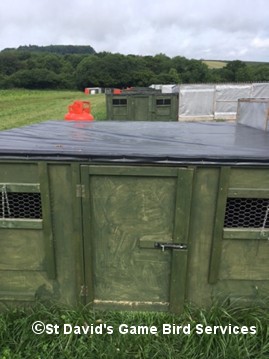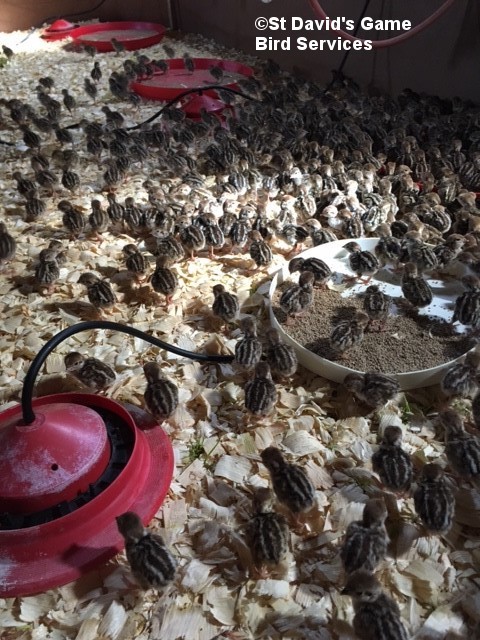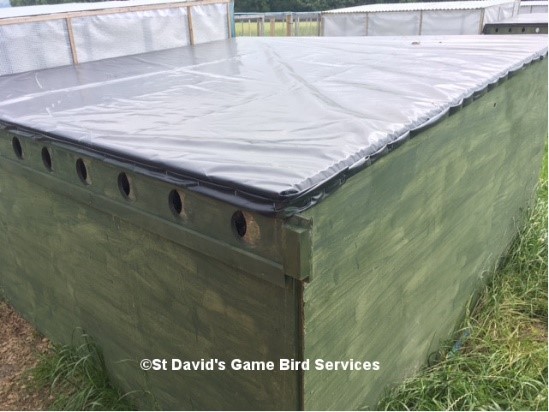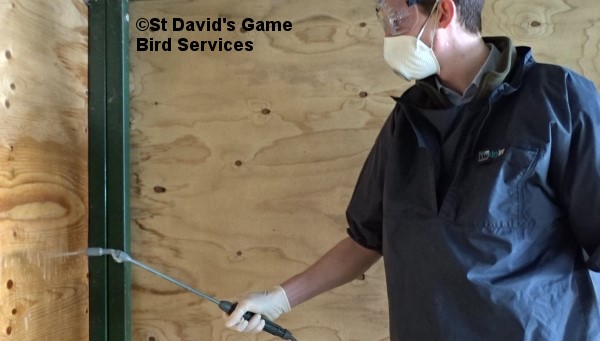Biosecurity
Do not let biosecurity be compromised at any stage on your rearing site or in your release pens. Letting your biosecurity guard down will lead to increased risks of disease transfer and substantial challenges for the newly hatched chicks. You must consider the following points for good biosecurity:

Fig 1 Biosecurity is important inside and out
Cleaning and disinfecting equipment
- Prepare for cleaning equipment in February and March.
- Clean all houses, pens, drinkers, feeders, quad bikes and trucks.
- Remember the 3 Ds:
- Drench - power wash everything to remove organic material.
- Allow to dry completely.
- Detergent - use a powerful cleaner and degreaser.
- Allow to dry completely.
- Disinfectant - spray a disinfectant known to kill Cocci and viruses.
- Clean water systems thoroughly - 24 hours with a hydrogen peroxide based clean to remove organic biofilm and algae.
- Replace all 5mm pipe as it's impossible to clean.
Fig 2 Power wash everything especially the corners of the sheds
Foot dips
- Wellies are good at spreading disease across pens and sites.
- Ensure foot dips are covered and regularly changed.
- Foot dips should be available for all transitions between different areas.
- Encourage everyone to use them.

Fig 3 Ensure foot dips are used between transition of areas
Visitors
- Visitors must sign in when accessing your sites.
- They are an unknown quantity when it comes to disease contamination.
- Avoid visitors entering live bird areas unless wearing suitable coveralls.
Vehicles
- Ensure that vehicles are kept clean.
- Provide a portable sprayer to disinfect wheels before driving onto the rearing sites.
- Avoid using the same vehicles in release pens and on rearing fields.
Husbandry
Layer Flock
- All laying flock must be caught up before February.
- If buying in stock ensure you know the disease status or have a vet visit.
- Provide adequate space for hens and cocks.
- Areas for nesting should be dry, covered and checked regularly.
- Provide plenty of nest boxes.
- Barriers can help reduce aggression between cock birds.
- A hen to cock ratio of 1:7 is acceptable.
- Provide constant access to clean, palatable water.
- Monitor body weights and consider worming prior to lay.
- Ensure the birds are on a good plan of nutrition leading to lay.
- The laying pens should be well away from disturbance and rearing fields.
- Keep up with rodent and predator control.
- Provide areas of cover from cold and wet weather.
Hatching and Brooding
- Hatcheries should be thoroughly clean and fumigated prior to setting eggs.
- Ensure temperatures are accurate and humidity is holding.
- Research laying flocks prior to buying in eggs.
- Once chicks hatch allow to dry before moving.
- Areas for brooding must be preheated to 32C ready for chick placement.
- Ensure clean bedding and easy access to clean water.
- Chick paper should be used and crumb spread out thinly - ~60g/chick.
- Use card to create a circle area in larger huts to maintain temperature and prevent huddling in corners.
- Do not be tempted to drop heaters low, keep them at recommended heights.
- Consider using a supplement in the water such as Chick Start in the first week of brooding to encourage chicks to drink.
- Avoid drafts in the shed and check temperatures regularly.
- Light should be diffused through the shed.
- Ventilation is very important to replace spent air and vent excess CO2, but ensure heat is not lost.

Fig 4 Use card to create a circle area to maintain temperature and prevent huddling

Fig 5 Spread the crumb out thickly over the chick paper
Rearing
- If using bits in your pheasants, consider supporting the poults through this stressful time with multivitamins or organic acids.
- Ensure bedding is always dry and free from stale feed or water.
- Ventilation is critical and should not cause drafts in the houses.
- Keep heaters on in the house for colder days.
- Poults should be hardened off using night shelters.
- Provide adequate feeding and drinking stations in the night shelters and flight pens.
- Consider 'strip grazing' partridge runs to prevent poaching the ground.
- Ensure predator control is continued.
- Be observant and if poults become ruffled and scour seek veterinary advice.
- Ensure pop-holes are large enough for birds to avoid weather and predators quickly.
- Consider providing shelter out in the flight pens.

Fig 6 Ensure pop-holes are large enough for birds to quickly avoid weather and predators
Release
- Catch up in the early morning so that poults have all day in the release pens to find water, feed and shelter.
- Consider using organic acids pre and post release.
- Pens should be well managed and ready for young poults.
- Ensure the pens contain low level cover for poults to roost.
- Pens should have areas of open grass and woodland.
- Consider worming the poults after 10-14 days once moved to release pens.
- Be observant for signs of disease and contact your vet immediately.
- Maintain predator control.
- Provide adequate amounts of feeders and drinkers.
- Water should be clean and palatable.
- Be cautious transferring poults to wheat, do it gradually over 3-4 weeks.






